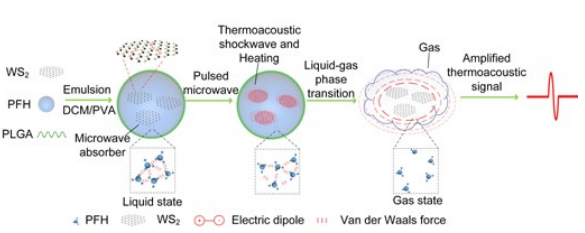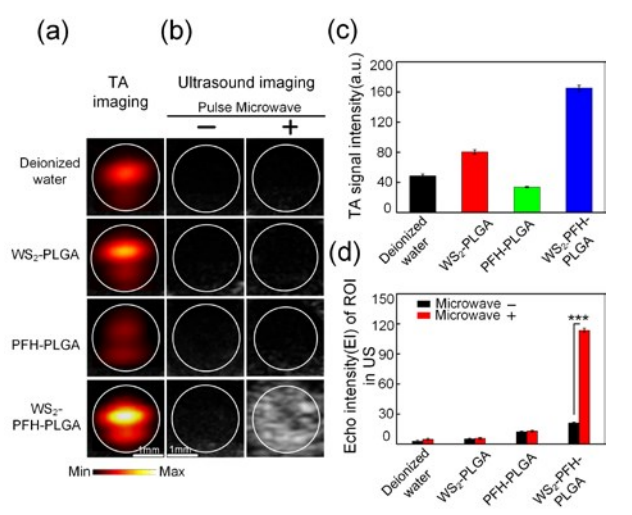文献:Stimulated liquid-gas phase transition nanoprobe dedicated to enhance microwave thermoacoustic imaging contrast of breast tumor
文献链接:https://pubs.rsc.org/en/content/articlelanding/2020/nr/d0nr04441e
作者:Le Zhang,Huan Qin, Fanchu Zeng, Zhujun Wu, Linghua Wu, Shuxiang Zhaoand Da Xing
相关产品:PLGA 聚乳酸羟基乙酸共聚物
原文摘要:Microwave-induced thermoacoustic imaging (MTAI), combining the advantages of the high contrast of microwave imaging and the high resolution of ultrasonic imaging, is a potential candidate for breast tumor detection. MTAI probes have been used to extend thermoacoustic to molecular imaging. However, due to the high content of water molecules in tissues,thermoelastic expansionbased probes used in conventional MTAI are not capable for inadequate enhancement. Herein, an MTAI nanoprobe for amplification of thermoacoustic (TA) signals by the stimulated liquid-gas phase transition mechanism has been developed, providing significantly higher signal amplitude than that from the conventional mechanism of thermoelastic expansion. The nanoprobe consists of liquid perfluorohexane (PFH) and tungsten disulfide (WS2) nanoparticle rich in defect electric dipoles. When irradiated with pulsed microwaves, the defect electric dipoles in WS2 were repeatedly polarized at gigahertz. This results in a localized transient heating and yielding acoustic shockwave, which destroys van der Waals forces between PFH molecules. Ultimately, liquid PFH droplets undergo a liquid-gas phase transition, generating dramatically enhanced TA signals. The practical feasibility was tested in vitro and in an animal model of breast tumor. The results show that the proposed nanoprobe can greatly improve the contrast of tumor imaging. It will be a new generation probe for MTAI.
PLGA具有良好的生物相容性,它能被加工成微球、纳米粒等多种形式,作为化合物载体将化合物包裹其中,实现化合物的缓释与控释。在组织工程中,PLGA 也可用于构建细胞支架,其降解速度可根据乳酸与羟基乙酸的比例进行调节,为细胞的生长、增殖和分化提供适宜的环境,促进受损组织的修复与再生。微波诱导热声成像(MTAI)结合微波成像高对比度和超声成像高分辨率的优点。MTAI探针已被用于将热声学扩展到分子成像。然而,由于组织中水分子的高含量,传统MTAI中使用的热弹性膨胀探针不能充分增强。基于此该文献开发了一种PLGA参与制备的利用受激液-气相变机制放大热声(TA)信号的MTAI纳米探针,提供了比传统的热弹性膨胀机制高得多的信号振幅。过程如下:

图:液-气相变纳米探针的热声(TA)信号放大机理研究
WS2-PFH-PLGA的合成
采用乳化液法制备了液-气相变纳米探针。首先,将PLGA颗粒溶解在二氯甲烷溶液中。然后,将富缺陷的WS2溶液和PFH溶液加入PLGA-CH2Cl溶液中,在超声冰浴中加入能量一段时间,然后将冷PVA溶液和异丙醇溶液加入乳化液体系,并在能量超声冰浴中进行乳化一段时间,使NPs表面凝固。最后,进行磁性搅拌,直到二氯甲烷蒸发。最后,离心一段时间,去除上清液,用去离子水沉淀,制备NPs。

图:WS2-PFH-PLGA对比增强能力的体外验证
结论:PLGA参与制备的纳米探针由富含缺陷电偶极子(PFH)液体全氟己烷和二硫化钨(WS2)纳米粒子组成。当脉冲微波照射下,WS2中的缺陷电偶极子在千兆赫处重复极化。这导致了局部瞬态加热和产生声冲击波,这破坏了PFH分子之间的范德华力。最终,液体PFH液滴发生液-气相变,产生增强的TA信号。该纳米探针可以提高tumor成像的对比度。

 2025-08-19 作者:ZJ 来源:
2025-08-19 作者:ZJ 来源:

